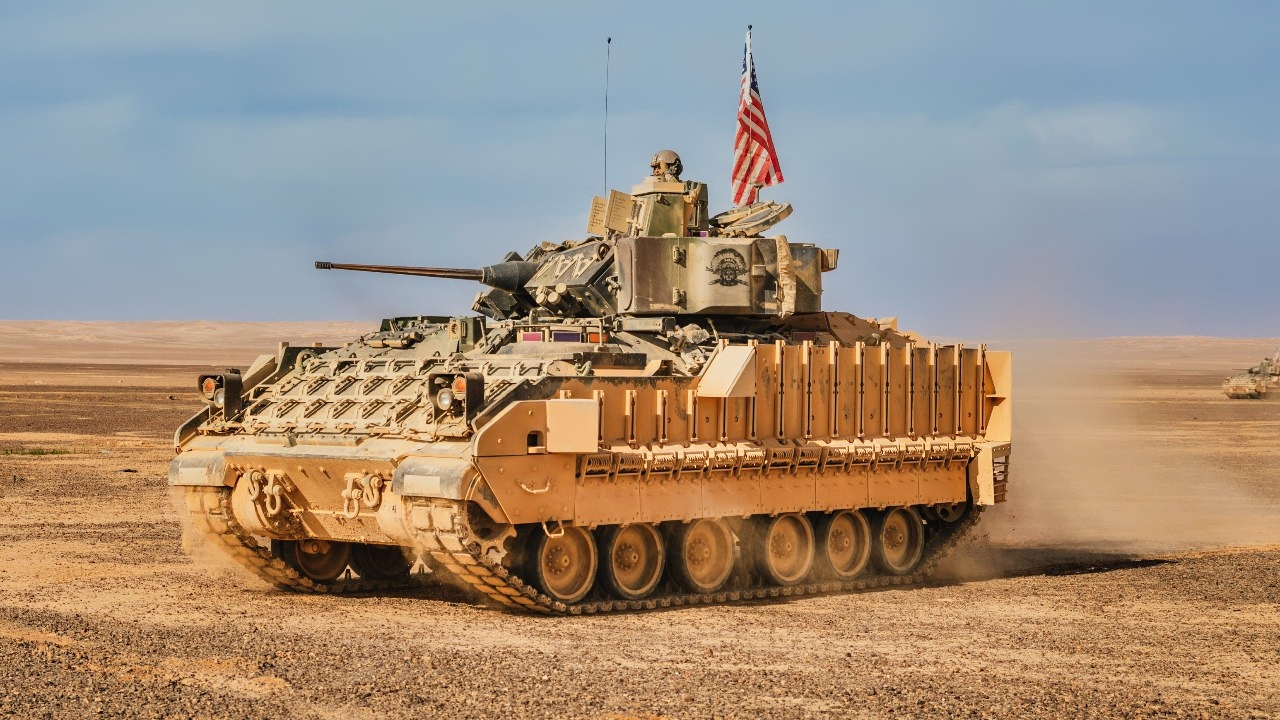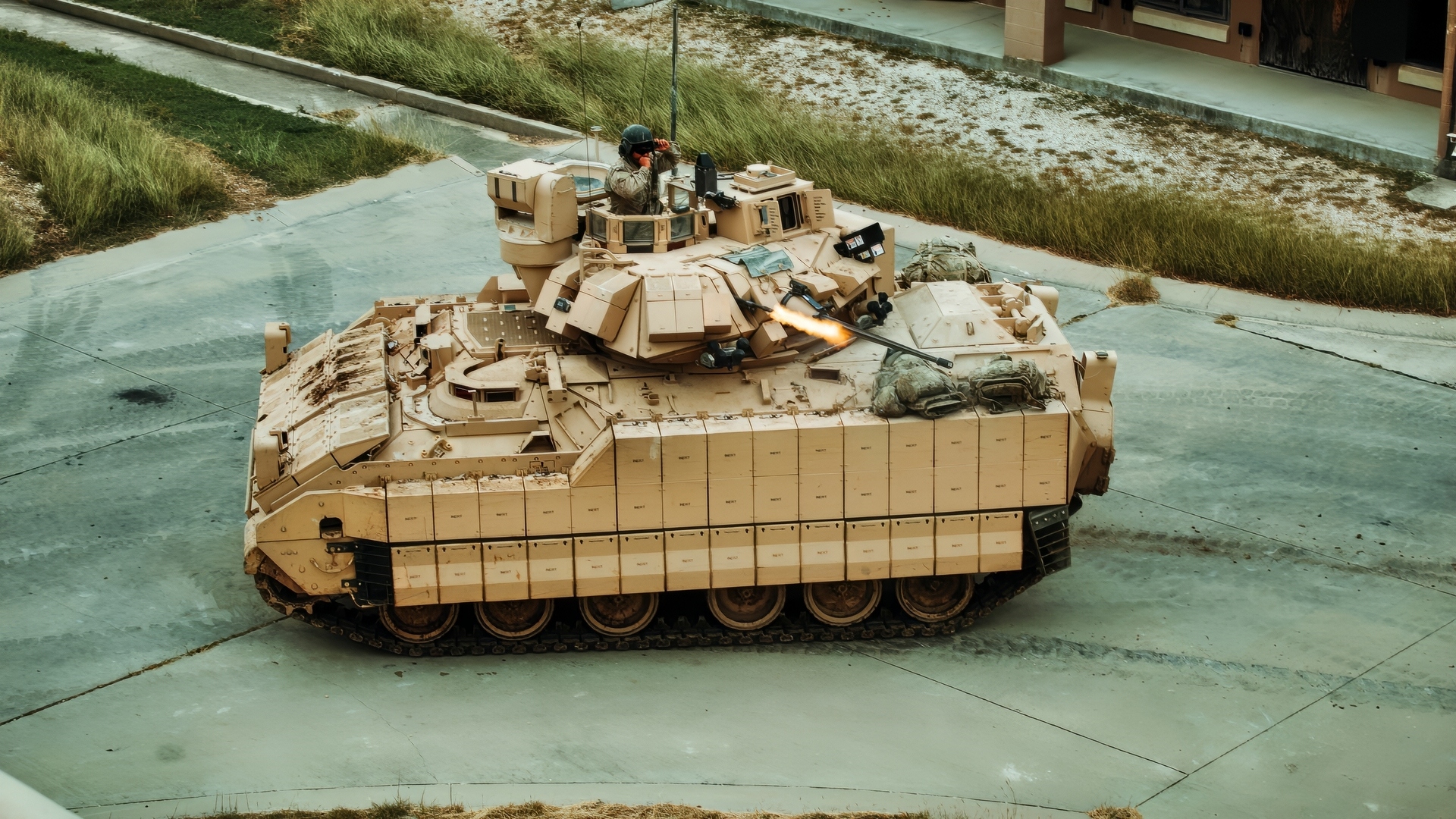Key Points and Summary – The XM30 Mechanized Infantry Combat Vehicle has cleared a key milestone and is moving into manufacturing development, but it will not reach U.S. armored brigades until the early 2030s.
-That leaves the Army relying on upgraded M2A4 Bradleys in a battlefield environment transformed by drones, precision artillery, and FPV suicide systems.

XM30. Image Credit: U.S. Army.
-Designed as a “born-digital” platform with a 50 mm cannon, modular armor, active protection, and open-architecture software, the XM30 is meant to fix the Bradley’s survivability and networking gaps.
-Yet schedule slips, industrial strain, and competing modernization programs mean the Army’s margin for error is shrinking fast.
The XM30 Needs To Come Soon
M2 Bradley Fighting Vehicles, which were first fielded in 1981, continue to serve as the backbone of U.S. mechanized infantry brigades, even as the XM30 Mechanized Infantry Combat Vehicle program – the Army’s plan to retire the Bradley – enters its most advanced phase.
They do so because the U.S. has no other choice – and because the Bradleys are still, in many ways, effective.
In June 2025 the U.S. Army approved the end of the XM30’s engineering phase, meaning the new infantry combat vehicles are now entering manufacturing development.
And while the milestone is a clear step forward for the program and the U.S. military, the cars won’t actually be fielded until the early 2030s – meaning U.S. armored brigades will continue to operate Bradleys well past their anticipated initial retirement.

Troopers with 3rd Armored Brigade Combat Team, 1st Cavalry Division firing the 25mm canon on a Bradley fighting vehicle in order to zero the vehicles weapons systems at a range in Poland. Ranges such as these familiarize troopers with the vehicles systems in order to ensure combat readiness.
The Bradleys won’t be the only asset at hand, however, and are expected to be operated alongside the new XM30 for at least a decade.
The timing matters. The Army has repeatedly noted the lessons learned from Ukraine, where armored vehicles face new challenges in the form of drone surveillance, precision artillery, and cheap explosive FPVS – a totally new environment for these 1980s-era platforms.
The XM30 is designed specifically for these conditions, but the extended timeline raises questions about how the Army will perform with these upgraded Bradleys before a full fleet of XM30s is deployed.
What the XM30 Is Designed to Deliver
The XM30 – launched initially as the Optionally Manned Fighting Vehicle before it was officially renamed in 2023 – is intended to become the Army’s core infantry fighting vehicle for its Armored Brigade Combat Teams.
The platform will fully replace the Bradley in the long term, while allowing operation with a crew or under limited unmanned control. It will also be able to direct autonomous or semi-autonomous systems on the battlefield.

U.S. Army Soldiers assigned to 2nd Squadron, 278th Armored Cavalry Regiment, Task Force Reaper, conduct movement procedures with M2 Bradley Fighting Vehicles during the Jade Cobra VI exercise in the U.S. Central Command’s area of responsibility, Feb. 19, 2025. Jade Cobra VI strengthens military-to-military partnerships, increases readiness, and facilitates security cooperation between the United States and Jordan. (U.S. Army photo by Staff Sgt. Hector Tinoco)
Much of the ambition that drives the XM30 program centers on addressing three key areas where the Bradley now struggles: lethality, survivability, and digital integration. Early requirements for the XM30 set out by the Army called for a 50 mm XM913 cannon in an unmanned turret – an upgrade that would allow for greater range and better armor penetration than the 25 mm gun used on the Bradley today.
The new vehicle is also expected to incorporate a modular armor suite, improved underbody blast protection, and an active protection system that’s capable of intercepting incoming threats before they strike. Ukraine has proven that these kinds of features are simply necessary today.
And just as importantly, Army planners have described the XM30 as a “born-digital” vehicle, built around the Modular Open Systems Architecture, which will enable faster software updates, new sensor-fusion packages, and integration with unmanned systems.
This isn’t an older analogue system upgraded to work with modern technology, but a digital-first platform that can operate with today’s advanced system and be more easily integrated into future systems, too.
The Army selected two competing teams, General Dynamics Land Systems and American Rheinmetall Vehicles, to produce prototypes in June 2025.
Both contracts reportedly cost around $1.6 billion for the development phase, with each company expected to make a total of 7 prototype vehicles ahead of an eventual down-select in 2027. If the schedules hold – and they may not – low-rate production is expected to begin in Fiscal Year 2028, followed by an initial fielding at the beginning of the 2030s.
A Shrinking Margin for Error
Despite the progress, the path to Milestone B – the production phase – was slower than Army leaders had hoped, which isn’t exactly an excellent indication for how it might go next.

Troopers with 3rd Armored Brigade Combat Team, 1st Cavalry Division firing the 25mm canon on a Bradley fighting vehicle in order to zero the vehicles weapons systems at a range in Poland. Ranges such as these familiarize troopers with the vehicles systems in order to ensure combat readiness.
The pause, however, was reportedly intended to give both industry teams more time to complete their design packages and ensure that the upcoming prototype phase could proceed without any further setbacks. So there was logic behind it.
Pushing the XM30 into the early 2030s, however, has created an unavoidable gap.
As the successor program moves forward, the Army continues to purchase upgraded M2A4 Bradleys to keep its brigades viable.
That’s an additional expense, but it’s necessary to prevent that gap from growing. In September 2025, the service awarded a $22.4 million contract modification to procure additional Bradleys, part of a broader strategy to extend the fleet until the XM30 becomes fully available.
And as the timeline stretches, there’s more than just money on the table. Sustainment and survivability risks will rise, and the delay even comes as the industrial base faces competing pressures.
Abrams modernization, Striker upgrades, and artillery programs are all drawing from the same pool of suppliers – and any disruption in one program can cascade into others.
The message? The XM30 needs to come soon. Very soon. But rushing the program risks even worse delays.
About the Author:
Jack Buckby is a British author, counter-extremism researcher, and journalist based in New York. Reporting on the U.K., Europe, and the U.S., he works to analyze and understand left-wing and right-wing radicalization, and reports on Western governments’ approaches to the pressing issues of today. His books and research papers explore these themes and propose pragmatic solutions to our increasingly polarized society. His latest book is The Truth Teller: RFK Jr. and the Case for a Post-Partisan Presidency.










